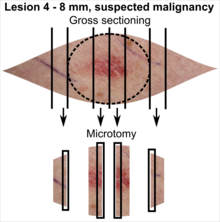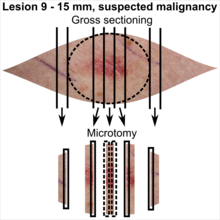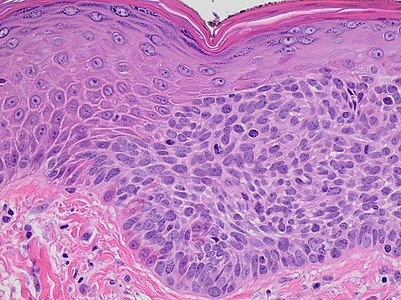Suspected malignant skin excisions
Author:
Mikael Häggström [note 1]
Suspected malignant skin excisions:
Contents
Fixation
Generally 10% neutral buffered formalin.
See also: General notes on fixation
Common targets
If directly suspected from the referral, see:
- Melanoma
Gross processing
Gross examination
Note:
- Color
- Well-defined or diffuse border
- Size
- Any elevation
See separate article in case of dark skin focalities
Tissue selection
| <4 mm | 4 - 8 mm | 9 - 15 mm |
|---|---|---|

|

|

|
In table above, each top image shows recommended lines for cutting out slices to be submitted for further processing. Bottom image shows which side of the slice that should be put to microtomy. Dashed lines here mean that either side could be used. Further information: Gross processing of skin excisions
Microscopic evaluation
If the lesion was pigmented on gross examination, evaluate as a dark skin focality. If not:
Look for atypical cells, possibly by scrolling through the epidermis at intermediate magnification and then through the dermis at a lower magnification. If atypical cells are found, look for:
- Similarity to epidermal basal cells, evaluate as suspected basal-cell carcinoma
- Similarity to squamous cells: See below:
Squamous cell-like skin proliferations: Differential diagnosis
Main differential diagnoses and their characteristics:[2]
Invasive squamous-cell carcinoma of the skin: Atypical and pleomorphic keratinocytes, involving the dermis and the sub-cutis with a potential metastatic spread.
Squamous-cell carcinoma in situ (Bowen’s disease): Atypical keratinocytes at every layer of epidermis.
Actinic keratosis: Atypical keratinocytes that do not span the full thickness of the epidermis (or, in Bowenoid variant, are less disordered with less nuclear atypia and crowding).
Verrucous squamous cell carcinoma[note 3]: Exophytic squamous proliferation with marked papillomatosis and low atypia and the presence of koilocyte-like changes. Found in head and neck locations, as well as in the genitalia and sole of the foot.
Inverted follicular keratosis:[note 4]: Sharply circumscribed endophytic verrucous proliferation with prominent squamous features.
Seborrheic keratosis: Acanthosis, absence of atypia, pseudo-horn cysts, in inflamed lesions, mitoses may be present.
A melanoma may have relatively plentiful eosinophilic cytoplasm, and be seemingly continuous with the squamous epithelium (at left in image), thus resembling a squamous cell carcinoma. However, the nesting of cells at right in the image is more characteristic of a melanoma.
General benign imitators of skin malignancy
Granulomatous skin inflammation often contains giant cells that may appear atypical.
Further workup of malignant findings
In case of skin cancer, determine whether the peripheral/radial and deep margins are clear, close or continuous.[3][note 5] A close margin has various definitions for different malignancies, but for basal-cell carcinoma and cutaneous squamous cell carcinoma it is defined as being closer than 1 mm from the edge (but yet non-continuous with it),[3][4] but 2-3 mm for melanoma.[5]
Previous biopsy
(At least if there is a known previous biopsy, look for changes that are consistent with a biopsy site, to confirm that it was taken from the excised area.) Such changes in the skin include:
- Granulation tissue in more fresh biopsies
- Dense collagen
- Fibrosis with vertical blood vessels
- Fibrosis that replaces solar elastosis
Reporting
Preferably see specific article on the condition at hand, if available.
- Optionally, the presence of a keratinized squamous epithelium.
- Any abnormalities, generally preceded by location in terms of epidermal, dermal or more specific layers thereof.
- If malignant:
- Degree of differentiation
- Radicality, mainly into either of the following:
- >___ mm (Definitions vary for the distance as per Further workup of malignant findings above): "Clear margins" (or: "Clear margins at over __ mm")((or the exact distance thereof)).))
- <___ mm but not continuous with edge: "Close margins at __ mm at (location). [[Locations are mainly the deep edge, or the (superior/inferior/medial/lateral) radial edge.]]." Numbers are generally given at an exactness of 0.1 mm.[3]
- Continuous with margin: "Not radically excised at (location)."
- For skin shave biopsies, non-radicality may be reported as: "Extending to base and peripheral edges of biopsy" (as they may not be regarded as "margins" on a biopsy).
- Perineural or vascular invasion if present.
Notes
- ↑ For a full list of contributors, see article history. Creators of images are attributed at the image description pages, seen by clicking on the images. See Patholines:Authorship for details.
- ↑ The excision example shows a superficial basal cell carcinoma.
- ↑ - Buschke–Löwenstein tumor is an alternative name for verrucous squamous cell carcinoma in the ano-genital region.
- Carcinoma cuniculatum is a characteristic form of verrucous squamous cell carcinoma on the sole. - ↑ Inverted follicular keratosis is generally thought to be a rare variant of seborrheic keratosis, but this position is not universally accepted.
- Karadag, AyseSerap; Ozlu, Emin; Uzuncakmak, TugbaKevser; Akdeniz, Necmettin; Cobanoglu, Bengu; Oman, Berkant (2016). "Inverted follicular keratosis successfully treated with imiquimod ". Indian Dermatology Online Journal 7 (3): 177. doi:. ISSN 2229-5178. - ↑ "Peripheral" or "radial" margins are preferred rather than "lateral", since a "lateral" margin may be interpreted as opposite to the "medial margin".
Main page
References
- ↑ There are many variants for the processing of skin excisions. These examples use aspects from the following sources:
- . Handläggning av hudprover – provtagningsanvisningar, utskärningsprinciper och snittning (Handling of skin samples - sampling instructions, cutting principles and incision. Swedish Society of Pathology.
- For number of slices and coverage of lesions, depending on size. - Monica Dahlgren, Janne Malina, Anna Måsbäck, Otto Ljungberg. Stora utskärningen. KVAST (Swedish Society of Pathology). Retrieved on 2019-09-26.
- For slices towards the pointy ends to determine radicality, which can be parallel to the slices through the lesions (shown), or as longitudinal slices that go through each pointy end. - . Dermatopathology Grossing Guidelines. University of California, Los Angeles. Retrieved on 2019-10-23.
- For microtomy of the most central side at the lesion - "The principles of mohs micrographic surgery for cutaneous neoplasia
- With a "standard histologic examination" that, in addition to the lesion, only includes one section from each side along the longest diameter of the specimen.
- It also shows an example of circular coverage, with equal coverage distance in all four directions.
- The entire specimen may be submitted if the risk of malignancy is high. - . Handläggning av hudprover – provtagningsanvisningar, utskärningsprinciper och snittning (Handling of skin samples - sampling instructions, cutting principles and incision. Swedish Society of Pathology.
- ↑ Initially copied from: Paolino, Giovanni; Donati, Michele; Didona, Dario; Mercuri, Santo; Cantisani, Carmen (2017). "Histology of Non-Melanoma Skin Cancers: An Update
". Biomedicines 5 (4): 71. doi:. ISSN 2227-9059.
"This article is an open access article distributed under the terms and conditions of the Creative Commons Attribution (CC BY) license (http://creativecommons.org/licenses/by/4.0/)." - ↑ 3.0 3.1 3.2 David Slater, Paul Barrett. Standards and datasets for reporting cancers - Dataset for histopathological reporting of primary cutaneous basal cell carcinoma. The Royal College of Pathologists. February 2019
- ↑ 1 mm as cutoff for close margin: Brodie M Elliott, Benjamin R Douglass, Daniel McConnell, Blair Johnson, Christopher Harmston (2018-12-14). New Zealand Medical Journal.
- ↑ Page 406 in: Klaus J. Busam, Richard A Scolyer, Pedram Gerami (2018). Pathology of Melanocytic Tumors . Elsevier Health Sciences. ISBN 9780323508681.
Image sources
















